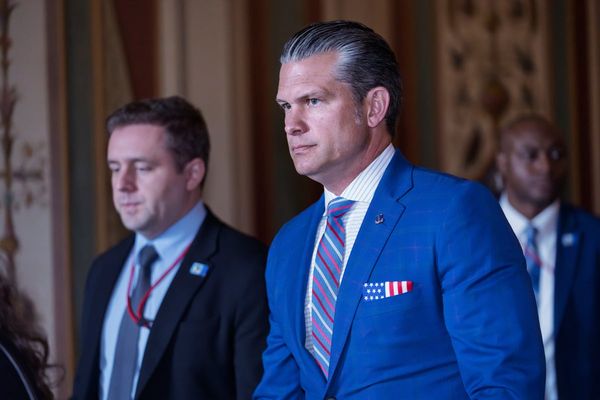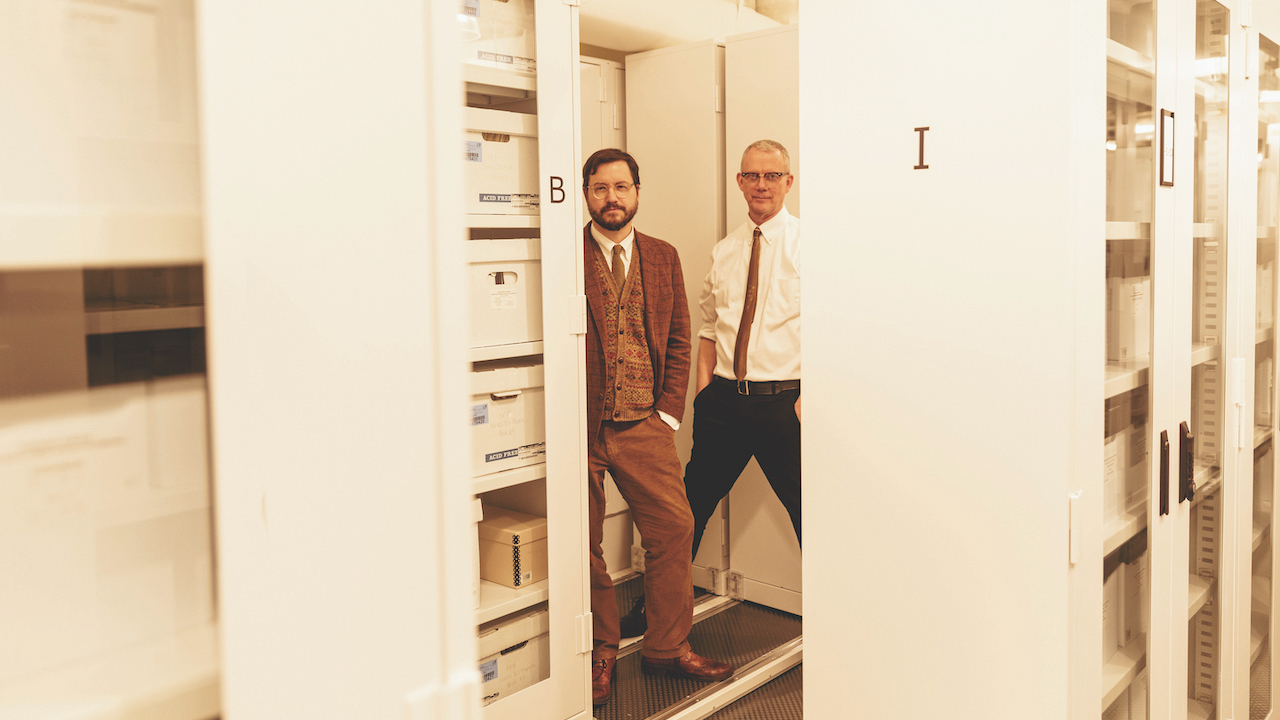
Throughout their 30-year career, Baltimore-based experimental electronic music couple Matmos have gained notoriety for their unconventional use of sampling. Across 14 albums, dating back to their 1997 self-titled debut, M.C. Schmidt and Drew Daniel have, amongst other things, recorded the sounds of surgical procedures, washing machines and freshly cut hair to create various forms of melodic techno, glitch, IDM and post-industrial music.
For their latest album, Return to Archive, the duo was commissioned by the Smithsonian Folkways record label to record an album in honour of its 75th anniversary. Founded in 1948 by Moses Asch, Folkway’s self-proclaimed mandate was to record the sounds of the entire world and commit them to vinyl. Thus, in their typically unique way, Matmos re-contextualise the sound of American frogs, dolphins, satellites, junkyards and the mud-dauber wasp, inviting the age-old musique concrète question – is this music or noise?
Since Matmos’ debut album in 1997, you’ve always been fascinated by the art of sampling. Where did this interest in using found sounds derive from?
Drew Daniel: “My first instrument was a mono tape recorder. I’d make recordings of my voice, and because the microphone was always distorting, I thought it was amazing that, through pause-editing, I could go from being this wimpy, powerless child to sounding like a scary monster. The next piece of gear was a delay pedal with a trigger mode, and then once I got a four-track I started chopping breaks and making very primitive hip-hop loops. As an adolescent, reading William S. Burroughs’ cut-up novels, using a tape recorder and listening to pop music, hip-hop and breakdancing became part of my queer response to the world. I wasn’t listening to Pierre Henry when I was 15 years old – that would come four or five years later.”
What was your first sampler?
DD: “My first boyfriend, Doug, owned a house and set up a layaway plan for me to purchase a Roland W-30 sampler, which blew my mind. I spent hours and hours making sounds, but didn’t understand anything about sequencing MIDI. It was only when I met M.C. that he taught me that I could plug these things into other things and talk to a computer that I realised I could control these shapes in a totally different way.”
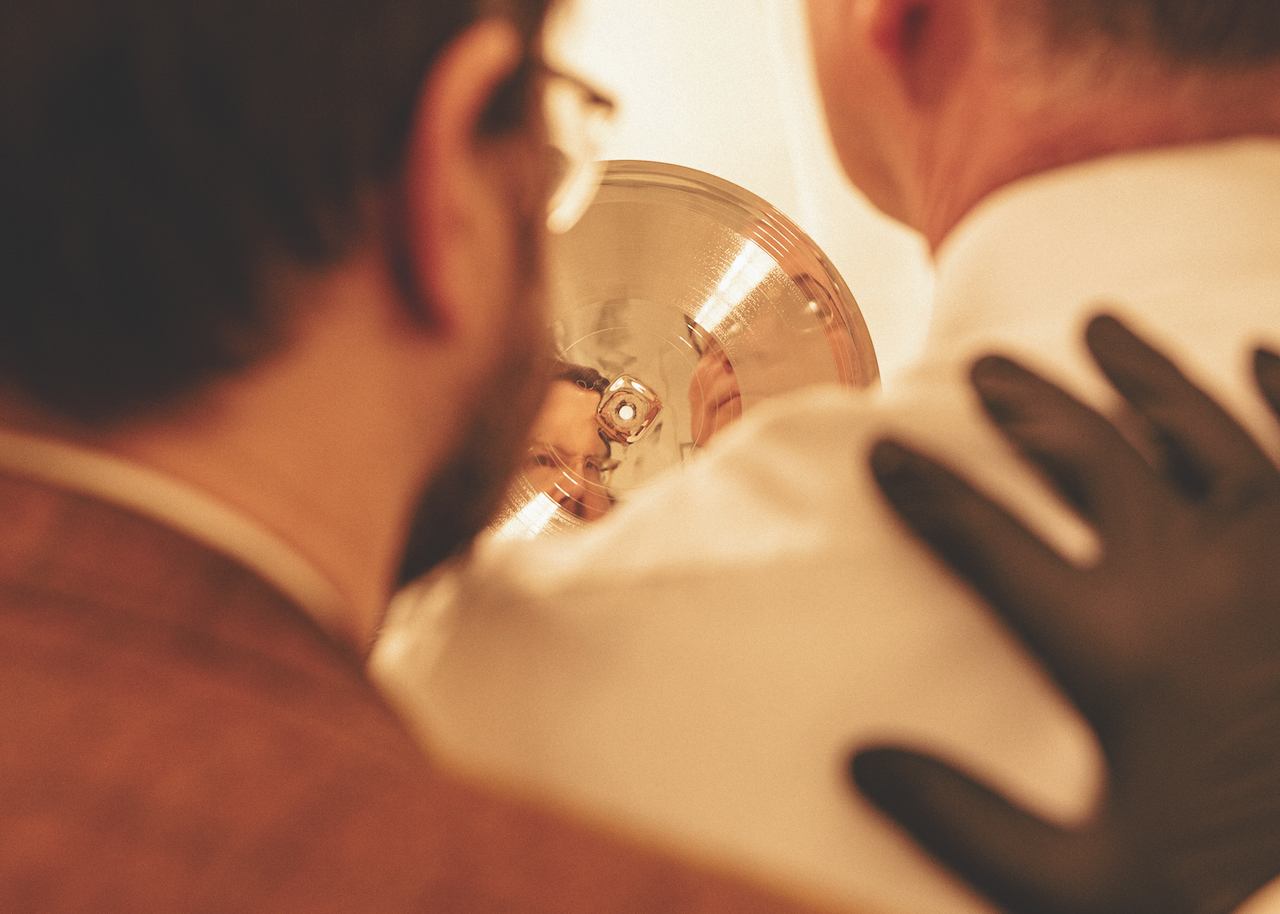
M.C. Schmidt: “I’m seven years older than Drew and got my first sampler in 1987. Samplers were the cool new thing, and I got the Ensoniq Mirage despite not knowing anything about it. I’d use the strings and that awful saxophone preset that the Mirage was so famous for, but I was using real sound, not synthesised sound. Before that, I’d been using synths like the Juno-60, JX-3P, SH-101 and a Sequential Prophet 10, which happened to be the same one that was used to make the soundtrack for Invasion of the Body Snatchers.”
DD: “When I met M.C., he’d made a really great insect sample on the Mirage that had featured in noise performances from his previous band Lao Core, but we went deep on the W-30s. Because of the artificial constraint of only having 27 seconds of sample time, you’d have to believe in every sound you used, but you could still do some amazing things by setting a very short loop time and scuttling across the length of a sample, effectively doing a Cubase-style time stretch in edit mode, which is as close as you can get to granular synthesis.”
Because sampling’s so much easier to do now, do you think those self-imposed limitations were a benefit?
DD: “It’s true that there aren’t the same constraints, because now I can put a terabyte’s worth of samples in a song. Over time, we’ve imposed artificial constraints on ourselves. If you tell yourself that you have to finish something in three months rather than four years, it puts a gun to your head, and you have to make choices and commitments.”
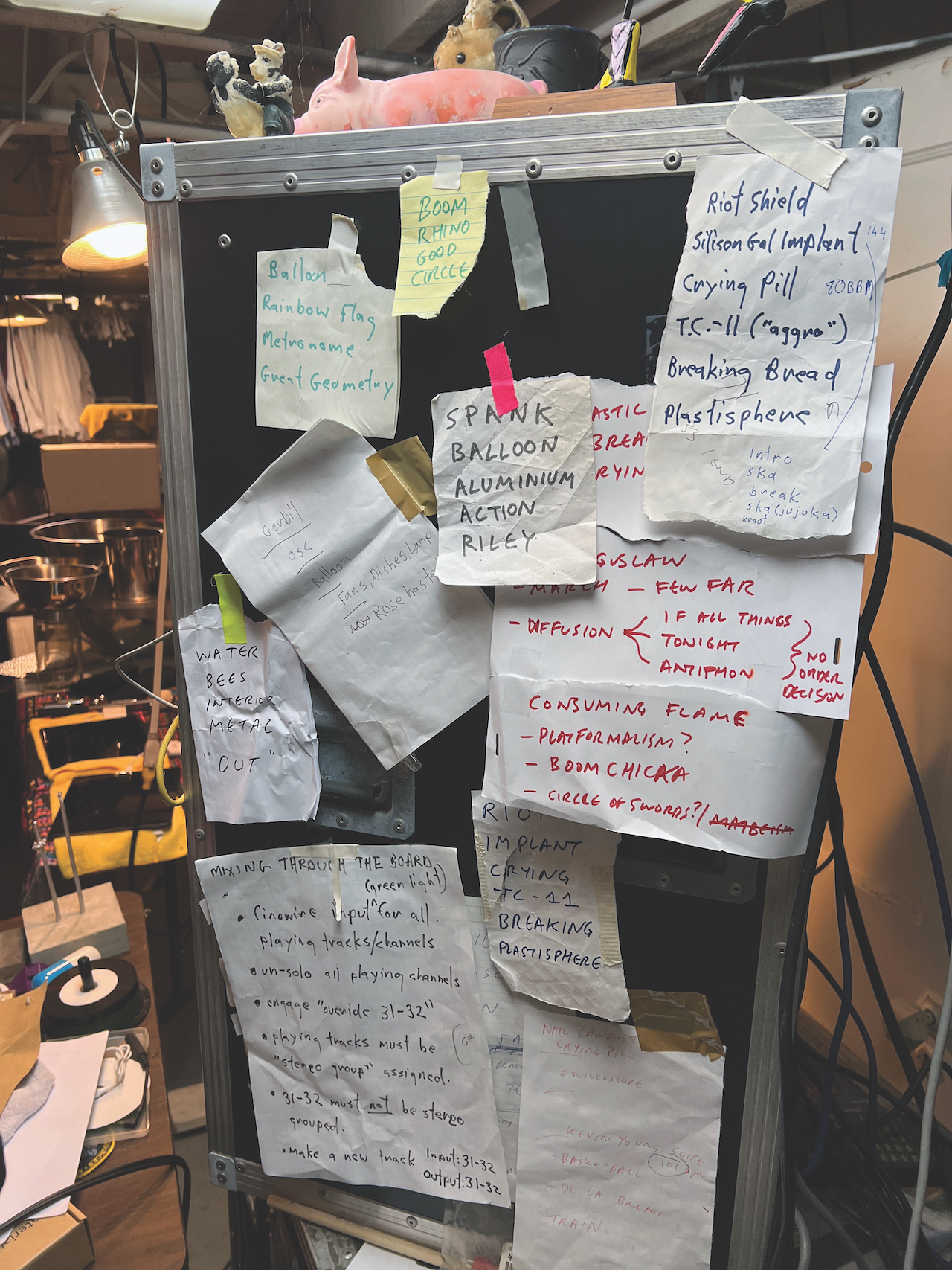
M.C.: “I teach in a music school, and it’s very difficult to convince my students to imagine there was no undo in your editing. The idea that once you make a decision, you can’t go backwards is really valuable. It sounds so banal now, but what Drew and I really came together on as Matmos was digital editing on Macromedia’s SoundEdit 16. Is it sampling? Kind of, but the nomenclature is misleading. Ultimately, we were building things out of tiny slices of other things.”
Are you interested in sampling other people’s music?
DD: “When people pooh-poohed the unoriginality of MC Hammer’s Can’t Touch This, they were making a statement about sampling being predatory and derivative, but we didn’t worry about those problems. For us, it became a lot more fun to sample ‘that thing’ in the room. Collage artists like Carl Stone, Vicki Bennett or Theo Parrish are real sampling auteurs and so gifted in the way they transform what they work with, but we always found it more compelling to sample the world itself – or anything but records.”
In the late ’80s and early ’90s, artists started to quit sampling each other, due to the hassle and expense of sample clearance. Was that a good thing?
DD: “I don’t like how it’s become this lavish culture where Justin Bieber and Kanye can clear anything just because major label artists have deep pockets. At our level, we’re not used to worrying about legality or permission. We do what we want to do because of the poeticism of what attracts us, but this latest record is a break from that, because the whole point is that Smithsonian Folkways gave us permission. It felt weird to be told, hey kids, here’s the candy store, go crazy and eat all you want.”
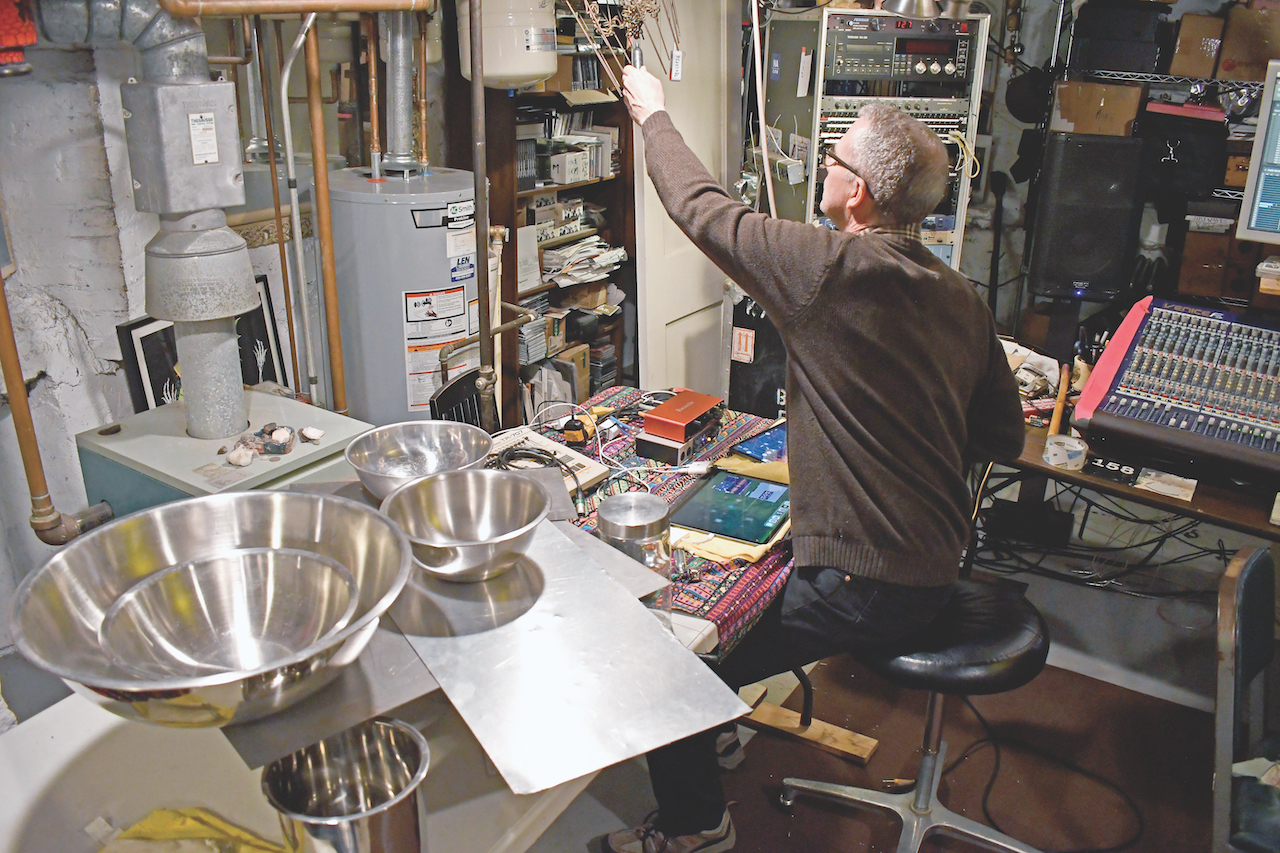
M.C.: “The sad thing about all the lawsuits was that a lot of sampling in those days was a love letter to old music. What it did for kids and their knowledge of old music was a beautiful thing and created the concept of crate diggers. When I talk to 20-year-olds now, they say, What the fuck is that? And I’m like, well, people used to build songs out of old songs, and having a vast knowledge of old songs made you a more powerful song-maker. The stupid thing is that, from a sales perspective, was De La Soul sampling The Turtles going to hurt the sale of Turtles’ records? No, it was going to increase the sale of their records, because nobody gave a shit about The Turtles at that point.”
DD: “I guess our solution was to have a different relationship with what makes a sound yours. When we made A Chance to Cut Is a Chance to Cure, which used recordings from a real surgery, there was a one-off nature to the sound source itself. It might be that my recording of a plastic surgery operation might resemble yours, but there’s usually something pretty singular about doing a field recording in that sort of space.
“It just became more interesting for us to test what we could do by saying, let’s make a song out of a latex t-shirt or the skin of a rabbit, and keep looking for more and more unusual objects or situations to create sound. We thought, instead of sampling James Brown, let’s recreate a banquet where King Ludwig of Bavaria’s horse went crazy and destroyed everything.”
Have you ever tried to exploit your approach to sampling for financial gain?
DD: “Pepsi approached us to make a jingle out of Pepsi cans, and we tried, but they didn’t like what we made. We literally tried to sell out and failed. Our goal wasn’t, oh, we’re going to make a collage of Ronald Reagan so you think he sucks: we thought, let’s make an entire album out of just our washing machine because it’s a gamble, and what if you can create a beautiful, psychedelic world from an everyday object that you might think is drab, boring and oppressive? To me, that can vindicate whole other ways of thinking about sampling – it doesn’t have to be about increasingly finely sliced variations of a dance music genre.”
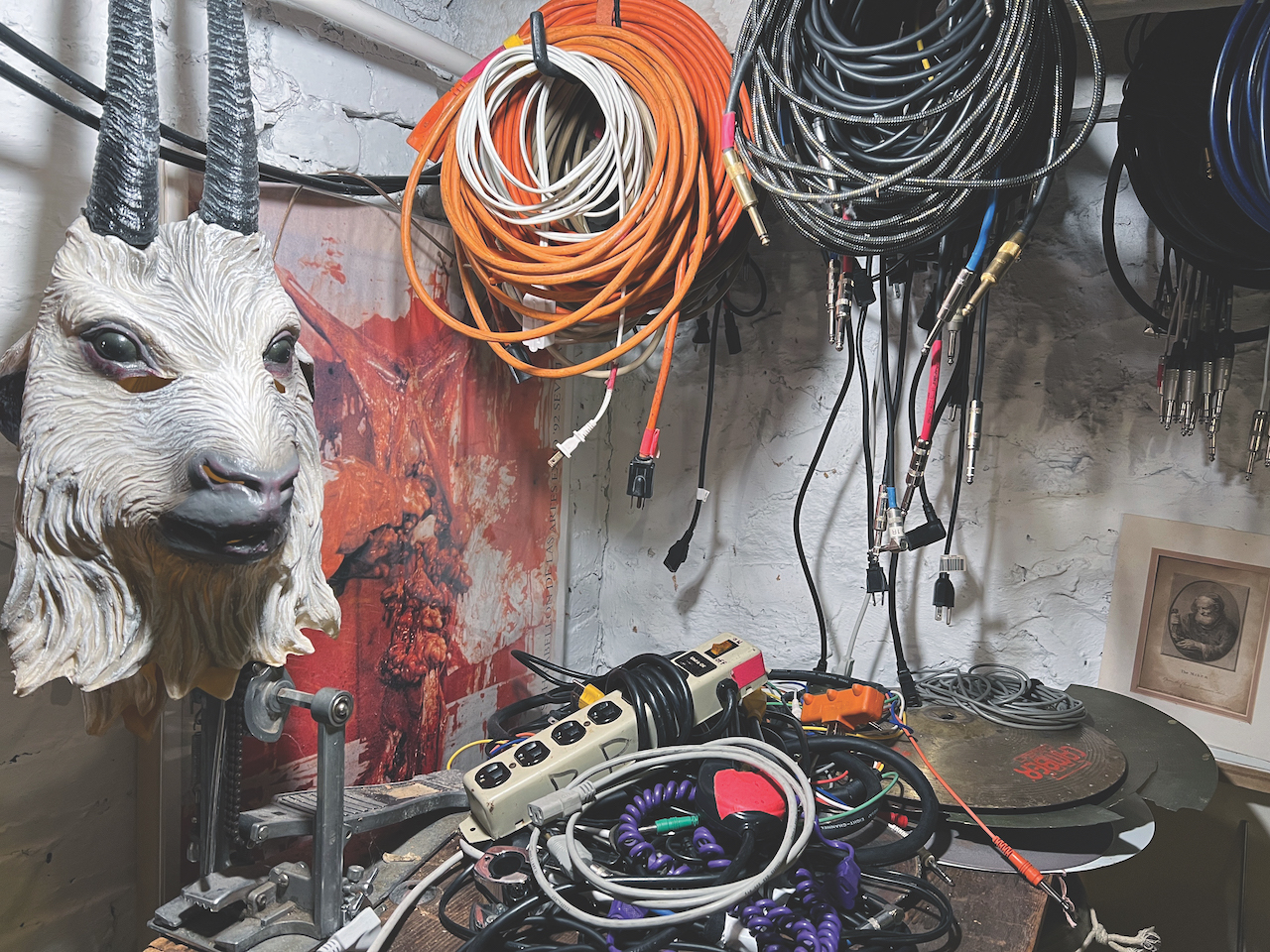
Do you always think of some sort of sample-based concept to build around before touching a sampler or instrument?
DD: “We take turns. M.C. is often driven by a sound or set of sounds that are inspiring to him and I’m the more pretentious one who thinks we should commit to a concept that determines what we do. We see the album as a unit of measurement, and so don’t tend to release a lot of one-off Matmos singles or EPs. Maybe after 31 years, we should question that.”
M.C.: “It’s sort of what people expect from us now, and that became clear when we made The Civil War in 2003. Journalists and listeners put a concept onto it, so we thought, let’s roll with that. We liked it when people bought and talked about our music, and it became very clear that they really liked the goofy sample idea, so we’re just being sluts.”
DD: “There’s a conceptual art mantra by Sol LeWitt that says ‘the idea is the machine that creates the work’. What we’ve found is that you can tie yourself in knots by saying, okay, we’re only going to work with plastic, but the plastic doesn’t give you an emotional mood, or a genre, or tell you whether something should sound empty, minimal or busy.
“It just says, make the cake out of this ingredient – the rest is up to you. We’re not genius songwriters or attuned to transposing our emotions; we’re more interested in stroking an object to see whether it seems to want to hang out at a certain pitch or tempo. It’s an encounter with the otherness of an object, or the whole world, rather than us looking inward.”

Although you don’t want to persuade the listener emotionally, is it important that they can at least link the music to the narrative behind it?
DD: “We don’t want to blow the listener’s ears out, and we love to use sounds that are super-bright, sharp and high-end. We also want the listener to listen to the albums over and over, but I don’t want to make them cry with a chord change. It’s weird now in this moment of cynical AI analysis of what makes pop songs work, but I think it’s creepy to engineer emotions, and would rather the music trust people to have some agency over what it does for them.”
M.C.: “We follow our nose. When I’m noodling on the keyboard, Drew will pull a slice from that take and build a whole new thing out of it. We don’t sit at the guitar and sing ‘my pain is real’, or whatever real musicians do…”
So why did you decide to relate this particular album to the Smithsonian Folkways label?
M.C.: “It’s not the kind of thing that most people say in interviews, but it was a commission from a guy at Smithsonian Folkways who we used to work with at Thrill Jockey. It’s the 75th anniversary of the label, so he called and asked if we would like to do something and we loved the idea.”
Pepsi approached us to make a jingle out of cans, and we tried, but they didn't like what we made. We tried to sell out and failed
DD: “We were given permission to sample anything from the catalogue, and immediately said that we don’t want to remix music. We wanted to approach the nature and science end of the catalogue rather than make a Deep Forest-style take on somebody else’s music and stick it on a techno chassis. M.C. and I both knew the Smithsonian Folkways label, because if you hang out in record stores you can’t miss their distinctive-looking vinyl jackets, and a lot of their records are so weird.
“Once we started listening to the full array of albums they’d digitised for us, we couldn’t believe how gnarly some of those records are. You expect placid birdsong or a spoken word record from some talking head, but then you get these records that are about the stomach of a healthy man eating lunch after smoking a cigarette, or speech after the removal of a larynx.”
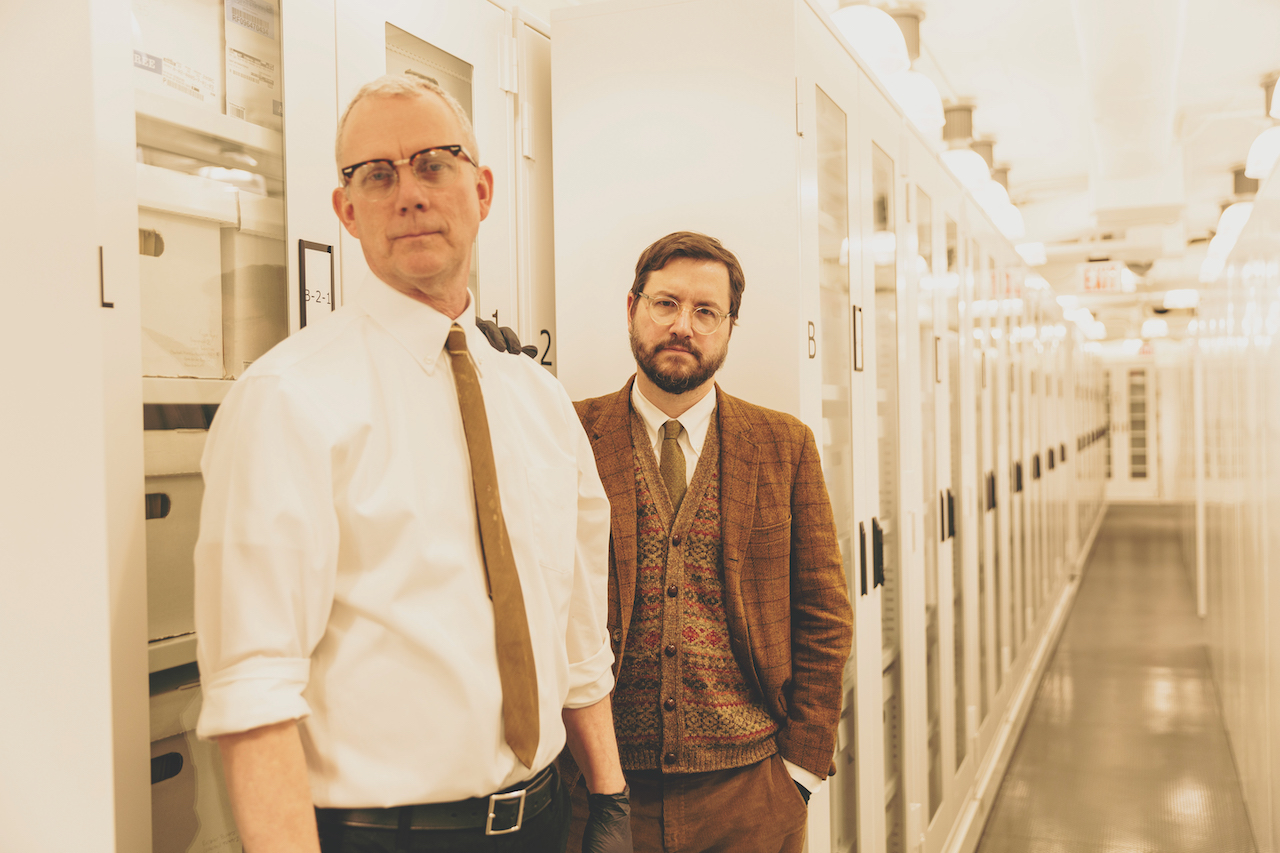
M.C.: “I fell in love with the album Ionosphere, which is full of these electromagnetic atmospheric disturbances that have righteous, crackling and roaring sounds, with no explanation in text or speech on the record itself. You can buy this horrifying record and, after many years, still not know what the hell you’re listening to.”
DD: “Ionosphere is just stab-you-in-the-face noise and the challenge was, great, we can sample all this stuff, but a lot of the sounds were not what we’d generally work with. They were very lo-fi and often distorted with tons of mid-range. There were some technical challenges in terms of ear fatigue risk and how we could sculpt things that would flow in a way that was not overwhelming, yet true to a track’s raw origin.”
M.C.: “I spent a lot of time going over that stuff using iZotope RX, which I had a weird feeling about because a lot of people have loved and listened to these records over the years, and yet I had to remove huge amounts of white noise.
DD: “I decided on one of the songs that instead of trying to fight the fidelity issue, I would exaggerate it. I took Albro T. Gaul’s recording of a mud-dauber wasp and ran it through the Flatenator setting in Ableton, which is really nasty. It pulls up everything in a signal to make it a brick, so I took that already distorted recording of a wasp’s wings that had a lot of bleary, messed up and overdriven sounds, flattened and chopped it into slices in Simplr, and sequenced rhythms with lots of silences and gaps so there would be big bursts between the quietness.”
We want the listener to listen to the albums over and over, but I don't want to make them cry with a chord change
When you see an image of a mud-dauber wasp and marry it to the recording, the track becomes somewhat revolting and scary…
DD: “Well, if you think of all those ’50s horror movies of a giant wasp or spider and use sound design to make small things sound big you can create these weird feelings. I’m glad that you felt something powerful from the track, and I’m not sorry if it was revolting to you.”
M.C.: “That’s funny, because when you said that, I immediately felt sorry for you [laughs]. I didn’t mean to make you feel bad; I was just doing my job. It was all about making the wasp really big and looking at it really closely. When I did the video, I was going to steal one from YouTube of this guy who goes up to a giant mud wasp nest and hits it with a stick. Unsurprisingly, wasps billow out of it and attack, so there are all these close-up wasps, mad as hell, flying around the video camera.”
How much of a task was it to go through the Smithsonian Folkways digital back catalogue to source what you wanted?
DD: “The initial list was around 130 albums, most of which were 40-minute LPs, so there was around 110 hours of listening – not all of it equally compelling. It was obvious early on that some of the spoken word records weren’t really our jam, and we’re pretty selective about when we let a human voice into the music. The song Music or Noise is one moment where we did dig in to that, but pretty soon we had a canon of 20 albums that we felt had a compelling source.”

Which ones stood out?
DD: “We knew that we’d use albums like The Lyrebird: A Documentary Study of Its Song, but Ultra-Sounds of the Bottle-Nose Dolphin, which appears on the tracks Lend Me Your Ears and Why?, was a tricky one, because listening to human people trying to teach dolphins to talk is hysterically funny. For Sounds of North American Frogs, we initially created a seven-minute frog techno monster piece that we eventually compressed into the first 40 seconds of the song Why? The most radical thing was M.C.’s 13-minute title track, because it’s more like a radio drama of sound effects. It doesn’t have rhythms or basslines, and it isn’t trying to be melodic.”
Is it a motivation of yours to create melody from sounds that are not inherently melodic?
DD: “If you just frame sounds as sounds, they will take on a compositional quality if you do it in the right way. For example, when you hear gun shell casings hitting concrete, it sounds like a little tinkling melody that’s repeating, but it’s literally just shell casings. It’s a gamble – some people are very moved about that minimalism and some people say, this is like watching paint dry and isn’t music. Then again, in this moment of ASMR, people are listening to someone chewing on a pickle that has 50,000 views on YouTube.”
M.C.: “With Return to Archive, I wasn’t trying to make melodies, but I was trying to make music in the extended sense. The general idea that Pierre Schaeffer created with musique concrète was whether we can make compelling music out of sound without pitch or the use of do-re-mi, and I think the answer is absolutely yes. Their nightmare was that people would call it sound effects music, but although they were thinking about orchestral symphonies rather than pop, you can build up and release tension and have excitement, climaxes and other narratives that aren’t pitched or derived from musical instruments. That’s what I was going for with Return to Archive – to create a compelling musical story.”
DD: “This is the noisiest Matmos record we’ve ever made, and I kind of love that. It doesn’t have the macho hang-ups that a lot of noise music from a certain generation has, where noise was a form of aggression or daddy’s-having-a-tantrum kind of music. As queer people, we’re pretty sceptical of that aggression and masculinity. I think the noise of the world and oddity of the sounds that we’re sampling is a place of fun and curiosity.
“Recordings are intimate encounters, right? Whether that’s a child learning to speak, someone recovering from surgery or a species of animal, the promise of a lot of these Folkways records was that, through these recordings, you could travel the world or through a social space virtually. Simple records like Sounds of the Office are so drab, but it’s become intensely exotic to hear people using typewriters and dictating memos. There’s one track that’s literally the sound of someone signing cheques.”
What did you use to piece together the various sound worlds on Return to Archive?
M.C.: “Basically, the whole album was made in Logic. Drew is the Ableton user and I’m the iPad apps user, and I primarily use an amazing app called Samplr, which is worth the price of an iPad alone. I can teach someone almost everything about this app in 20 minutes.”
DD: “I’m not an Ableton samurai by any means, but I use it to make rhythms, basslines and keyboards, and I’m heavily indebted to Kentaro Suzuki’s LFO-Cluster VST, and used that extensively. It’s a solar system of cascading LFOs that are related but distinct to each other, and you can map them to parameters. I’ll fill up Sampler or Simpler in Ableton, put some EQs and filters on, and then flood every single parameter with different LFOs chained to other LFOs using the LFO-Cluster technique.
I’m not an Ableton samurai by any means, but I use it to make rhythms, basslines and keyboards
“The result is that you very quickly get this endlessly morphing, self-garbling, destroying and rebuilding wormhole of weird sounds. The other thing we did that was a little unusual is that we noticed we weren’t getting enough bass out of these records because of how mid-range-heavy they are, so I set up two AKG C414 microphones in our living room and turned our stereo amp all the way up to the point that it was just at the edge of turntable feedback, and made a room recording of needle drops on a Technics SL-1200 turntable to generate a bass response out of violently playing a record. Technically, it’s still a sample of the record, but in many ways you’re creating this acoustic feedback experience of the needle becoming a microphone for the speaker.”
M.C.: “That’s some hilarious Matmos-does-some-conceptual-bullshit. A normal person would think, I want a heavy bass sound so I’ll make it with a synthesiser, but we’re out here and actually working for you people!”
Matmos’ Return to Archive is out now on Smithsonian Folkways.
Matmos: their go-to gear
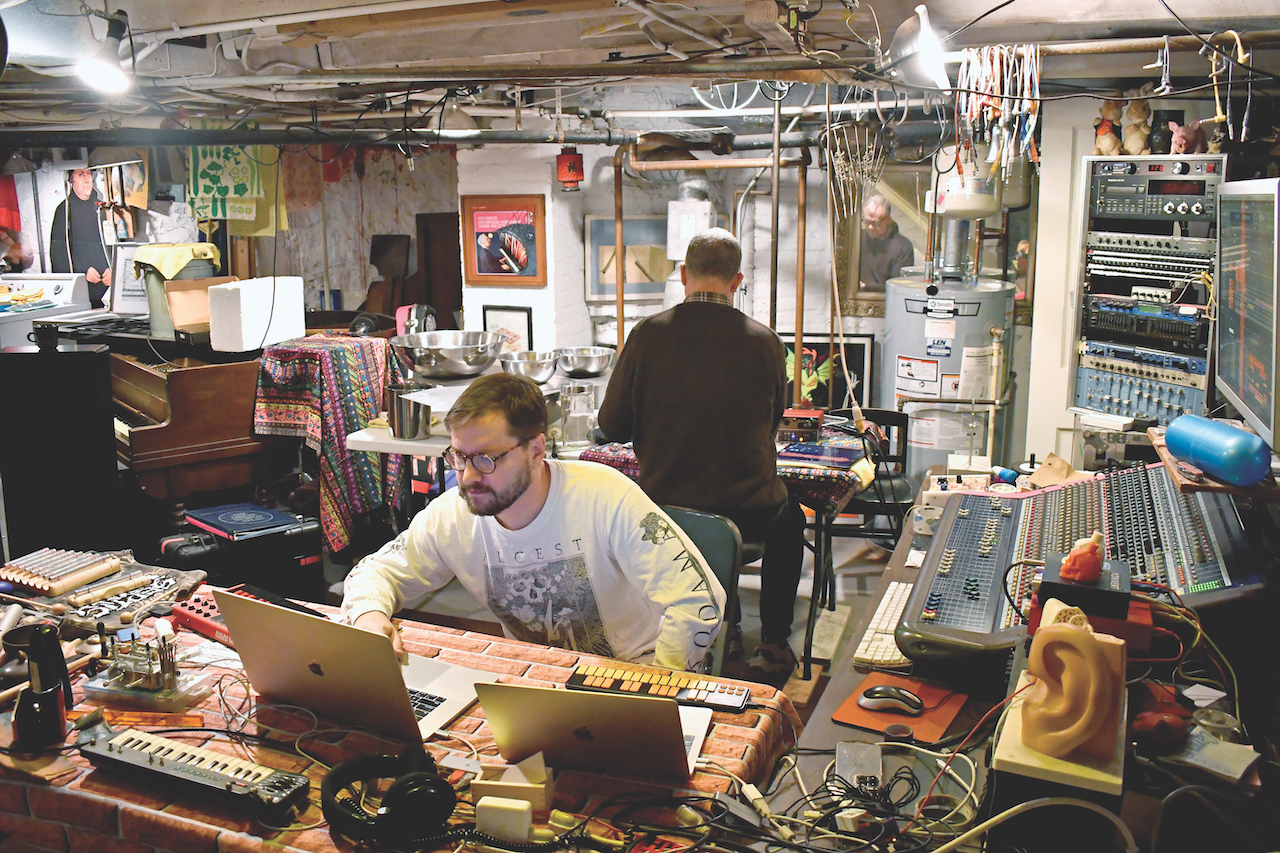
“M.C.’s beloved synth and our first go-to when an analogue synth is called for in a Matmos track. We have a grey one and a red one, just in case!”
“Flexible, versatile, fast-acting, and it works with Ableton Link. M.C. uses this iPad app constantly, both in the studio and in live performances. Because it’s so fast and has such a conveniently designed user interface, it works really well when improvising.”
“We used this app to clean up and transform 50-year-old source material that is often buried under grime, hiss, vinyl crackles and pops, but it can also be used to distort and transform audio in very powerful ways if you use the software against the grain.”
“This VST plug-in is designed by KentaroSuzuki and lets you build a tiny little ‘solar system’ of related but distinct LFOs that cycle and chase each other. You can map these to all sorts of parameters in soft synths and samplers, and the result is beautifully controlled chaos.”
Barcus Berry Planar Wave Transducer
“Intended for use in grand pianos, this can actually be used as a versatile, clean and loud-sounding contact microphone. We used it on the bars of a rat cage, and it sounded gorgeous.”

